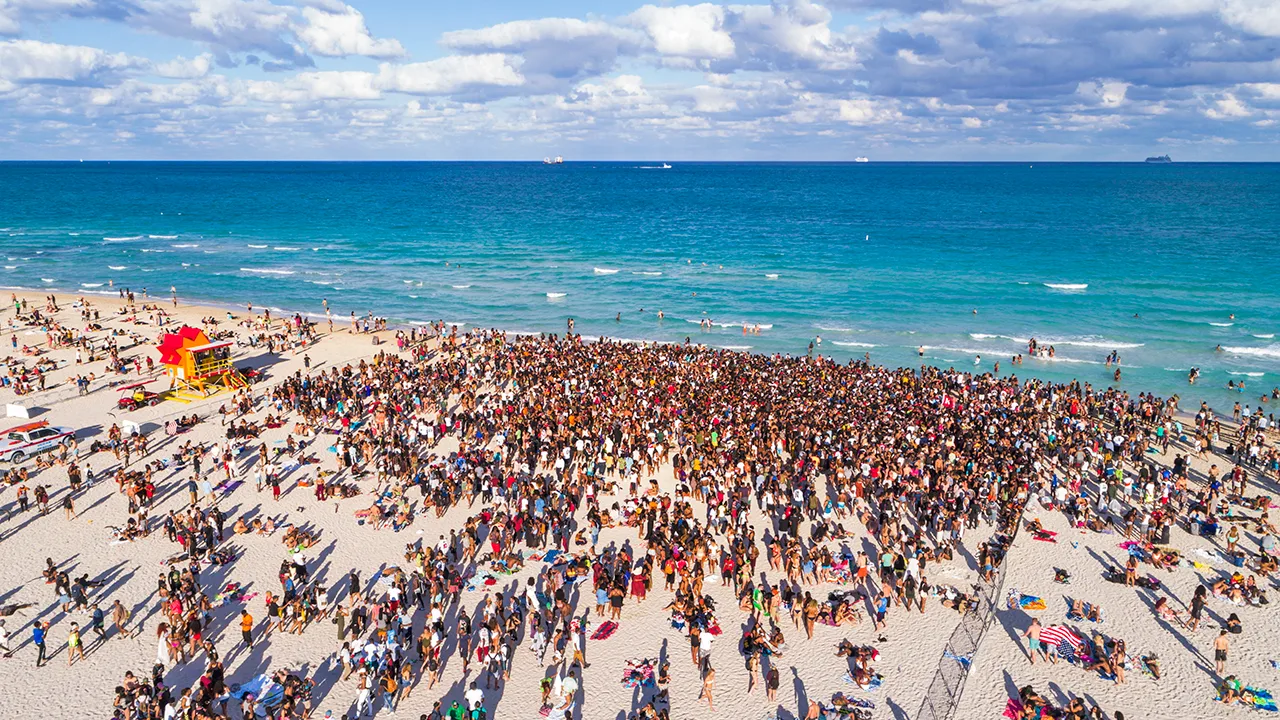
Complete Miami Spring Break Safety Guide: Preventing Car Accidents in 2025
Spring break in Miami draws thousands of visitors each year, transforming the city into one of the nation’s most popular vacation destinations. While Miami offers pristine beaches, vibrant nightlife, and unforgettable experiences, it also presents unique safety challenges—particularly regarding transportation and road safety.
According to recent statistics, spring break season correlates with a significant increase in traffic incidents, making road safety awareness crucial for both visitors and residents. This comprehensive guide aims to provide essential information on navigating Miami safely during spring break, with a particular focus on preventing car accidents and understanding your legal rights should an incident occur.
Table of Contents
- Spring Break in Miami: By the Numbers
- Traffic Safety Concerns During Spring Break
- Common Causes of Car Accidents During Spring Break
- Miami’s Most Dangerous Roads and Intersections
- Transportation Options Beyond Driving
- Florida Traffic Laws Visitors Should Know
- What to Do After a Car Accident in Miami
- Understanding Florida’s No-Fault Insurance System
- When to Contact a Car Accident Attorney
- Additional Spring Break Safety Tips
- Resources for Spring Break Visitors
- Frequently Asked Questions
- Conclusion
Spring Break in Miami: By the Numbers
Spring break season, typically spanning from late February through early April, brings approximately 570,000 college students to Florida’s beaches each year, with Miami being among the top destinations. This influx creates substantial pressure on local infrastructure, particularly roadways.
Recent Spring Break Statistics:
- Miami-Dade County sees an average increase of 18-22% in traffic volume during peak spring break weeks.
- According to the Florida Department of Highway Safety and Motor Vehicles (FLHSMV), car accidents increase by approximately 15-20% during March and April in Miami-Dade County compared to other months.
- In 2023, Miami-Dade County recorded over 1,800 traffic crashes during the six-week spring break period, resulting in 12 fatalities and more than 950 injuries.
- The Florida Department of Transportation reported that nearly 30% of spring break-related crashes involved out-of-state drivers unfamiliar with local roads.
- DUI arrests in Miami Beach increase by approximately 47% during spring break weeks compared to non-peak periods.
- According to a 2023 study by the Miami-Dade Police Department, approximately 22% of spring break traffic incidents involved pedestrians or cyclists.
- Data from the National Highway Traffic Safety Administration shows that drivers aged 18-24 (the primary spring break demographic) are 17% more likely to be involved in traffic accidents than other age groups.
Traffic Safety Concerns During Spring Break
Spring break in Miami creates a perfect storm of traffic safety concerns that both visitors and residents should be aware of:
Congestion
Miami’s streets, particularly in popular areas like South Beach, Downtown, and Wynwood, experience extreme congestion during spring break. In 2023, traffic volume on MacArthur Causeway (the main access to South Beach) increased by 32% during peak spring break days. This congestion leads to:
- Longer commute times (average travel times increased by 24 minutes during peak hours)
- Increased risk of fender benders and rear-end collisions
- Emergency vehicle response delays averaging 7-12 minutes longer than usual
Unfamiliar Roads
Many spring break visitors are navigating Miami’s complex road system for the first time:
- GPS dependency can lead to sudden lane changes and missed turns
- Confusion at Miami’s numerous roundabouts and one-way streets
- Misunderstanding of local traffic patterns and rush hours
Impaired Driving
Despite increased law enforcement presence, impaired driving remains a serious concern during spring break:
- In spring 2023, Miami Beach Police Department conducted 87 DUI arrests during a three-week period in March
- Blood alcohol content (BAC) levels among those arrested averaged 0.13%, well above Florida’s legal limit of 0.08%
- According to Miami-Dade medical examiner reports, 32% of traffic fatalities during spring break 2023 involved alcohol or other substances
Distracted Driving
The excitement of vacation combined with unfamiliar surroundings creates prime conditions for distracted driving:
- Cell phone use for navigation, photos, and social media sharing
- Multiple passengers engaging in lively conversation
- Sightseeing while driving
- Sleep deprivation affecting reaction times and attention spans
Common Causes of Car Accidents During Spring Break
Understanding the most common causes of spring break car accidents can help visitors take preventative measures:
Alcohol and Substance Impairment
- Nearly 40% of all spring break traffic fatalities in Florida involve alcohol
- The average BAC in fatal crashes during spring break is 0.15%, nearly twice the legal limit
- According to NHTSA data, reaction time decreases by approximately 12-15% at the legal BAC limit, and by 63% at a BAC of 0.15%
Distracted Driving
- In 2023, the Florida Department of Highway Safety and Motor Vehicles attributed 4,982 crashes to distracted driving in the first quarter of the year
- Cell phone use increases stopping distance by an average of 70 feet at 55 mph
- Taking eyes off the road for just 5 seconds at 55 mph is equivalent to driving the length of a football field blindfolded
Speeding and Aggressive Driving
- The Florida Department of Transportation reported that speeding was a factor in 31% of spring break traffic fatalities in 2023
- Miami-Dade County traffic cameras documented a 22% increase in speed limit violations during March 2023
- Tailgating incidents increased by 28% during peak spring break weeks compared to the annual average
Fatigue
- Many spring break visitors drive to Florida from distant states, sometimes driving through the night
- According to the CDC, being awake for 18 hours produces impairment equal to a BAC of 0.05%
- Drowsy driving crashes are 4 times more likely to occur between midnight and 6 a.m.
Unfamiliarity with Local Traffic Laws
- Visitors from states without right-on-red laws may cause confusion at intersections
- Misunderstanding of Florida’s move-over law leads to dangerous situations for emergency vehicles
- Confusion about Miami’s numerous school and construction zones with reduced speed limits
Miami’s Most Dangerous Roads and Intersections
Knowing which areas to approach with extra caution can help spring break visitors navigate Miami more safely:
High-Risk Roads
- I-95 Miami Corridor
- Recorded 62 fatal crashes in the past five years
- Experiences over 300 accidents per year during spring break season
- Heavy congestion between 7-10 a.m. and 3-7 p.m.
- US-1 (South Dixie Highway)
- Named one of Florida’s most dangerous highways
- High pedestrian accident rate, particularly near University of Miami
- 28 fatalities recorded in the past three years
- Collins Avenue (A1A)
- Runs through Miami Beach’s busiest tourist areas
- High concentration of pedestrians crossing outside designated crosswalks
- Recorded 1,200+ accidents in the past five years
- MacArthur Causeway
- Main access route to South Beach
- Experiences severe congestion during peak hours
- Limited shoulder space for emergency stopping
- Alton Road
- Frequent flooding issues during rainy season
- Construction projects often change traffic patterns
- High volume of rideshare pickups and dropoffs causing unexpected stops
Dangerous Intersections
- NE 2nd Avenue and 36th Street
- Consistently ranks among Miami’s top 5 accident locations
- Complex intersection with multiple turn lanes
- High pedestrian traffic from nearby Design District
- Brickell Avenue and SE 8th Street
- Financial district congestion during business hours
- Pedestrian-heavy area with frequent jaywalking
- Complex intersection with multiple lanes and turn options
- SW 8th Street and SW 27th Avenue
- High volume of traffic entering/exiting from multiple directions
- Frequent red-light running incidents
- Limited visibility during certain hours due to sun position
- NW 87th Avenue and NW 36th Street
- Complex intersection near Miami International Airport
- Confusion from out-of-town visitors heading to/from airport
- Heavy truck traffic creating visibility challenges
- US-1 and SW 22nd Avenue
- Long wait times leading to driver impatience
- Poor lighting conditions at night
- History of side-impact collisions
Transportation Options Beyond Driving
One of the most effective ways to prevent car accidents during spring break is to utilize alternative transportation methods:
Public Transportation
- Metrorail: Connects downtown Miami to southern Miami-Dade County with 23 accessible stations
- Metromover: Free automated people mover system covering downtown Miami and Brickell
- Metrobus: Extensive bus network with more than 95 routes throughout Miami-Dade County
- Tri-Rail: Commuter rail connecting Miami-Dade, Broward, and Palm Beach counties
Miami-Dade Transit offers a convenient Transit App that provides real-time arrival information and trip planning. During spring break 2023, public transit ridership increased by 28% compared to the same period in 2022, reflecting growing awareness of these options.
Rideshare and Taxis
- Uber and Lyft operate extensively throughout Miami
- Designated pickup and dropoff zones exist at popular locations
- Average wait time during spring break is 8-12 minutes
- Miami Beach has established dedicated rideshare zones to reduce traffic congestion
- Traditional taxi services remain readily available and can be hailed on the street
According to the Miami Beach Transportation Department, rideshare services completed over 780,000 trips during spring break 2023, a 15% increase from the previous year.
Trolleys and Shuttles
- Miami Beach Trolley: Free service with routes covering most of Miami Beach
- Miami Trolley: Free service with routes throughout downtown Miami, Brickell, Wynwood, and other popular neighborhoods
- Hotel Shuttles: Many hotels offer complimentary beach and downtown shuttles
These free services transported over 1.2 million passengers during spring break 2023, helping to reduce the number of vehicles on congested roads.
Micromobility Options
- Citi Bike: Bike sharing program with 170+ stations throughout Miami and Miami Beach
- Electric Scooters: Available in designated areas of Miami
- Walking: Many popular areas are pedestrian-friendly with wide sidewalks
Miami’s Department of Transportation counted over 245,000 scooter trips and 180,000 bike-share rides during spring break 2023.
Florida Traffic Laws Visitors Should Know
Understanding local traffic laws is essential for safe driving in a new environment:
Florida’s No-Fault Insurance System
Florida operates under a no-fault insurance system, meaning each driver’s insurance covers their own injuries regardless of who caused the accident. Visitors should verify that their insurance provides adequate coverage in Florida before arrival.
Move Over Law
Florida’s Move Over Law requires drivers to:
- Move over one lane for stopped emergency vehicles, sanitation vehicles, utility service vehicles, and wreckers
- If moving over is not possible, reduce speed to 20 mph below the posted speed limit
- Violations can result in fines of $120+ and 3 points on your license
Right Turn on Red
Right turns at red lights are generally permitted in Florida after coming to a complete stop, unless specifically prohibited by signage. This may differ from regulations in visitors’ home states.
Texting While Driving
As of 2019, texting while driving is a primary offense in Florida, meaning officers can stop drivers solely for this violation. Fines start at $30 for first-time offenders and increase with subsequent violations.
Seat Belt Laws
- All front seat occupants must wear seat belts
- All passengers under 18 must wear seat belts regardless of seating position
- Children under 4 must be in a federally approved car seat
- Children ages 4-5 must be in a car seat or booster seat
DUI Laws
- Legal BAC limit is 0.08%
- Enhanced penalties apply for BAC of 0.15% or higher
- First offense carries potential jail time of up to 6 months, fines of $500-$1,000, and license suspension
- Open container laws prohibit possession of open alcoholic beverages in vehicles
What to Do After a Car Accident in Miami
Despite taking precautions, accidents can still occur. Knowing the proper steps to take afterward can protect your health, safety, and legal rights:
Immediate Steps
- Ensure Safety First
- Move to a safe location if possible
- Turn on hazard lights
- Set up emergency flares/triangles if available
- Call 911
- Report the accident, especially if there are injuries
- Request medical assistance if needed
- Wait for police to arrive and file a report
- Exchange Information
- Driver’s license numbers
- Vehicle registration details
- Insurance policy information
- Contact information
- License plate numbers
- Document the Scene
- Take photos of vehicle damage from multiple angles
- Photograph the overall accident scene, including road conditions and signage
- Note weather and lighting conditions
- Record the positions of all vehicles involved
- Gather Witness Information
- Collect names and contact details of witnesses
- Ask if they would be willing to provide a statement
Follow-Up Actions
- Seek Medical Attention
- Visit a hospital or urgent care even if injuries seem minor
- Some injuries may not be immediately apparent
- Medical documentation is crucial for insurance claims
- Notify Your Insurance Company
- Report the accident promptly
- Provide factual information about the incident
- Do not admit fault
- Keep Detailed Records
- Medical reports and bills
- Vehicle repair estimates
- Correspondence with insurance companies
- Work absences and lost income documentation
- Accident-related expenses
- Consider Legal Consultation
- Florida’s no-fault system has exceptions for serious injuries
- Consult with a car accident attorney to understand your rights
- Most initial consultations are free
Understanding Florida’s No-Fault Insurance System
Florida’s unique insurance system can be confusing for out-of-state visitors:
Personal Injury Protection (PIP)
- Florida requires all drivers to carry at least $10,000 in PIP coverage
- PIP covers 80% of medical expenses and 60% of lost wages, regardless of fault
- Benefits are limited to $2,500 if not diagnosed with an “emergency medical condition”
- Out-of-state visitors’ insurance policies may function differently in Florida
Property Damage Liability (PDL)
- Florida requires minimum PDL coverage of $10,000
- Covers damage to another person’s property in an accident you cause
- Does not cover damage to your own vehicle
When You Can Step Outside the No-Fault System
Florida law allows accident victims to pursue claims against at-fault drivers in cases of “serious injury,” defined as:
- Significant and permanent loss of an important bodily function
- Permanent injury within a reasonable degree of medical probability
- Significant and permanent scarring or disfigurement
- Death
Rental Car Considerations
Spring break visitors often rely on rental cars, which present unique insurance considerations:
- Rental companies offer collision damage waivers (CDWs) that may duplicate existing coverage
- Personal auto insurance may extend to rental vehicles
- Some credit cards provide rental car coverage when used for the rental transaction
- International visitors typically need to purchase insurance from the rental company
When to Contact a Car Accident Attorney
Not every accident requires legal representation, but certain situations warrant consulting with an attorney:
Signs You May Need Legal Assistance
- Serious injuries requiring extensive medical treatment
- Disputed liability for the accident
- Insurance company offering a settlement that seems inadequate
- Complex scenarios involving multiple vehicles or parties
- Accidents involving commercial vehicles
- Incidents involving uninsured or underinsured drivers
- Cases where permanent disability or significant scarring results
Benefits of Legal Representation
- Navigating Florida’s Complex Laws: An attorney familiar with Florida’s unique legal system can provide invaluable guidance
- Proper Valuation of Claims: Attorneys can help ensure all damages are properly calculated, including future medical expenses and non-economic damages
- Evidence Collection: Professional investigation may uncover evidence that would otherwise be missed
- Negotiation Expertise: Experienced attorneys understand insurance company tactics and can negotiate more effectively
- Trial Representation: If a fair settlement cannot be reached, an attorney can represent you in court
The Contingency Fee Structure
Most car accident attorneys work on a contingency fee basis, meaning:
- No upfront costs to the client
- Attorney fees are paid as a percentage of the settlement or verdict
- If there is no recovery, there is typically no fee
- Initial consultations are usually free
This structure makes legal representation accessible to accident victims regardless of financial situation.
Additional Spring Break Safety Tips
Beyond road safety, spring break visitors should consider these general safety measures:
Beach Safety
- Rip Current Awareness: According to the Miami Beach Ocean Rescue, lifeguards performed over 430 rescues during spring break 2023, primarily due to rip currents. Learn to recognize the signs:
- A channel of churning, choppy water
- Notable differences in water color
- A line of foam, seaweed, or debris moving steadily seaward
- A break in the incoming wave pattern
- Swimming Safety:
- Swim only in designated areas with lifeguards present
- Check beach warning flags before entering the water
- Never swim alone or under the influence of alcohol
- Miami-Dade Fire Rescue reported responding to 112 water-related emergency calls during spring break 2023
- Sun Protection:
- Apply sunscreen (SPF 30+) every 2 hours
- Wear protective clothing and hats
- Stay hydrated
- Local hospitals reported treating over 650 cases of severe sunburn during spring break 2023
Personal Safety
- Buddy System: Travel in groups, especially at night
- Accommodation Security: Use all available locks and security features
- Valuables: Use hotel safes and avoid displaying expensive items
- Emergency Contacts: Save local emergency numbers and know your location
- Alcohol Consumption: Pace yourself and know your limits
- Situational Awareness: Stay alert to your surroundings at all times
COVID-19 Considerations
While restrictions have eased, visitors should still consider these health precautions:
- Follow any remaining local health guidelines
- Consider outdoor activities when possible
- Maintain good hand hygiene
- Respect others’ personal space and health choices
- Stay home if experiencing symptoms
Resources for Spring Break Visitors
Emergency Contacts
- Emergency Services: 911
- Miami Beach Police (Non-Emergency): (305) 673-7900
- Miami-Dade Police (Non-Emergency): (305) 476-5423
- Florida Highway Patrol: *FHP (*347) on mobile phones
- Miami Beach Fire Department: (305) 673-7120
- Tourist Information Hotline: 311
Helpful Apps
- Miami Beach e-Gov: Official city app with information on parking, events, and services
- MDT Tracker: Real-time updates on Miami-Dade Transit options
- Florida 511: Traffic information and road conditions
- https://apps.apple.com/us/app/gasbuddy-find-pay-for-gas/id406719683GasBuddy: Find the cheapest gas prices nearby
- Waze: Community-based traffic and navigation
- Uber/Lyft: Rideshare services
Visitor Centers
- Miami Beach Visitor Center: 1901 Convention Center Drive, Miami Beach
- Greater Miami Convention & Visitors Bureau: 701 Brickell Avenue, Suite 2700, Miami
- South Beach Welcome Center: 1001 Ocean Drive, Miami Beach
Recent News and Initiatives
Miami has implemented several new safety initiatives for the 2025 spring break season:
- Enhanced DUI Checkpoints: The Miami-Dade Police Department has announced increased DUI enforcement with additional checkpoints throughout Miami Beach, Downtown Miami, and other popular nightlife areas.
- “Safe Ride” Program: A new program offering discounted rideshare services between 10 p.m. and 4 a.m. during peak spring break weeks. Visitors can access special codes through the Miami Beach app.
- Expanded Trolley Service: Miami Beach has added additional trolleys and extended hours during spring break to provide free transportation options.
- Beach Ambassador Program: Miami Beach has deployed trained “Beach Ambassadors” to provide information, assistance, and promote safety awareness among visitors.
- Traffic Flow Modifications: Several streets in South Beach will convert to one-way traffic during peak evening hours to improve traffic flow and emergency vehicle access.
- License Plate Readers: Enhanced technology has been installed on major access points to Miami Beach to identify stolen vehicles and those associated with wanted individuals.
- Spring Break Information Portal: A dedicated website (miamibeachspringbreak.com) provides real-time updates on traffic conditions, event information, and safety alerts.
Frequently Asked Questions
Car Accident FAQs for Spring Break Visitors
Q: I’m from out of state and got into an accident in Miami. Which state’s laws apply?
A: Florida laws apply to any accident that occurs within the state, regardless of where you’re from. This includes Florida’s no-fault insurance system, which may differ significantly from your home state’s system. Your out-of-state insurance policy will still provide coverage, but the way claims are processed will follow Florida regulations.
Q: Do I need to report my accident to the police if it seems minor?
A: Yes. In Florida, you are required by law to report any crash resulting in injury, death, or property damage of $500 or more. Given today’s repair costs, most accidents exceed this threshold. Additionally, a police report provides official documentation that will be valuable for insurance claims and potential legal action.
Q: How long do I have to file a car accident claim in Florida?
A: Florida has a statute of limitations of four years from the date of the accident for most personal injury claims. However, it’s strongly advised to begin the process immediately, as evidence can disappear quickly and witness memories fade. For insurance claims, most policies require “prompt” reporting, typically meaning within 24-48 hours.
Q: Can I still recover damages if I was partially at fault for the accident?
A: Yes. Florida follows a “pure comparative negligence” system, which means you can still recover damages even if you were partially at fault, but your recovery will be reduced by your percentage of fault. For example, if you have $10,000 in damages but are found to be 30% at fault, you could recover $7,000.
Q: What if the driver who hit me was uninsured?
A: Your Personal Injury Protection (PIP) coverage will cover the first $10,000 of your medical expenses and lost wages, regardless of fault. Beyond that, if you have Uninsured/Underinsured Motorist (UM/UIM) coverage on your policy, it can provide additional compensation. If not, you may need to pursue a personal lawsuit against the at-fault driver.
Q: I was using a rental car during spring break. How does insurance work?
A: If you purchased insurance through the rental company, that policy will typically provide primary coverage. If you declined that coverage, your personal auto insurance usually extends to rental vehicles. Additionally, some credit cards provide rental car coverage when you use them to pay for the rental. Check your policies before declining rental company insurance.
Q: Can I pursue a claim against a drunk driver who caused my accident?
A: Yes. While Florida’s no-fault system generally limits lawsuits, cases involving drunk driving often meet the “serious injury” threshold that allows you to step outside the no-fault system. Additionally, in cases of DUI, you may be eligible to pursue punitive damages, which are designed to punish particularly reckless behavior.
Q: What if my injury symptoms appear days after the accident?
A: This is common, particularly with soft tissue injuries, whiplash, and concussions. Florida law gives you 14 days to seek medical treatment after an accident if you want to use your PIP benefits. Seeing a doctor immediately after an accident, even if you feel fine, creates documentation that connects any later-appearing symptoms to the accident.
Q: Do I need a lawyer for a minor fender bender?
A: Not necessarily. For very minor accidents with no injuries and clear fault, you can often handle the claim directly with insurance companies. However, even seemingly minor accidents can lead to complications. Most reputable attorneys offer free consultations to help you determine if legal representation would be beneficial in your specific situation.
Q: As a non-Florida resident, will I need to return to Miami for court proceedings?
A: Most car accident claims settle without going to trial. If your case does require court appearances, many proceedings can be handled by your attorney without your presence. For essential appearances, accommodations like video conferencing may be possible. A local Miami attorney can help minimize the need for you to return to Florida.
General Spring Break Safety FAQs
Q: What areas should I avoid during spring break in Miami?
A: Rather than avoiding specific areas, exercise increased caution in highly congested locations during peak hours. Areas like Ocean Drive in South Beach, parts of Downtown Miami, and popular nightlife districts experience extreme crowding between 10 p.m. and 3 a.m. If visiting these areas, consider going earlier in the day or using official rideshare zones to avoid the worst traffic.
Q: Are there curfews or special rules during spring break?
A: Miami Beach occasionally implements emergency measures during extremely busy periods, including earlier alcohol cutoff times, beach access restrictions, or capacity limits in certain areas. Check the official Miami Beach website or app for current notifications before heading out, especially on weekends.
Q: What is the best way to get around Miami during spring break?
A: Public transportation and rideshare services are highly recommended. The free trolley systems, Metrorail, and Metromover provide excellent coverage of most tourist areas. For trips to and from South Beach, using rideshare services can help you avoid parking difficulties and potential DUI risks.
Q: How can I protect my belongings at the beach?
A: Never leave valuables unattended on the beach. Consider using a waterproof pouch for essential items you need to keep with you, and leave other valuables locked in your hotel safe. Some beaches offer locker rentals, and certain companies provide waterproof security cases that can be attached to beach furniture.
Q: Is spring break in Miami family-friendly?
A: Miami has many family-friendly areas, but parts of South Beach and certain nightlife districts become very adult-oriented during spring break. For family trips, consider staying in areas like Bal Harbour, Sunny Isles, or Key Biscayne, which maintain a more relaxed atmosphere while still offering beach access and activities suitable for all ages.
Conclusion
Spring break in Miami offers incredible experiences and lasting memories, but safety should remain a top priority—especially on the roads. By understanding local traffic patterns, knowing Florida’s unique traffic laws, making responsible transportation choices, and being prepared for emergencies, visitors can significantly reduce their risk of being involved in a car accident.
Should an unfortunate incident occur, knowing the proper steps to take afterward can protect your health, legal rights, and financial well-being. Remember that local resources, including legal professionals specializing in car accidents, are available to provide guidance and support.
As Miami continues to evolve its approach to spring break safety, visitors who prioritize responsible decision-making contribute to a safer, more enjoyable experience for everyone. By planning ahead, staying informed about local conditions, and making safety-conscious choices, you can focus on creating positive spring break memories rather than dealing with preventable accidents and injuries.
Whether you’re a first-time visitor or a returning spring breaker, we hope this guide helps you navigate Miami safely and confidently. Enjoy all that our beautiful city has to offer, and remember that safety enhances rather than diminishes the spring break experience.
We’re Here to Help
If you or someone you love has suffered an accident during spring break in Miami, call us immediately at (305)501-8021). Our experienced team of accident attorneys is available 24/7 to provide the guidance and representation you need during this difficult time.
Don’t let an accident ruin your spring break or leave you with lasting financial consequences. Our firm specializes in helping visitors navigate Florida’s complex legal system, and we understand the unique challenges faced by out-of-state accident victims. From dealing with insurance companies to securing proper medical care, we’ll handle every aspect of your case so you can focus on recovery.
Call (305)501-8021) now for a free, no-obligation consultation.




